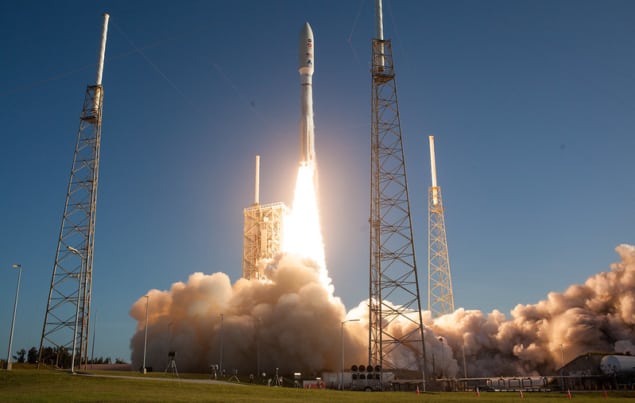ASA launches Mars Perseverance rover
31 Jul 2020
The summer of Mars launches continued yesterday as NASA successfully sent its Mars 2020 on a seven-month journey to the red planet. Taking off from the Kennedy Space Center in Florida at 7:50 a.m. local time, the probe is the third mission sent to Mars in just 10 days following China’s Tianwen-1 orbiter and rover as well as the United Arab Emirates’ Hope orbiter. All three craft will reach the red planet in February 2021.
The Mars 2020 mission is set to land in a river delta within Jezero Crater and it will aim to repeat the same thrilling entry, descent and landing that happened for NASA’s Curiosity rover in 2012, which continues to roam the martian surface today. The main aspect of Mars 2020 is the Perseverance rover that will use seven instruments to explore Mars’ geology and climate and look for signs of past microbial life. “The science goal ultimately is to search for signs of life,” says Mars 2020 team member Melissa Rice, “like biosignatures that would be preserved in the rocks and to understand the geologic context in which these rocks formed.”
The rover also carries an instrument to test the conversion of atmospheric carbon dioxide into oxygen – something that future crewed explorations would require. The drilling arm on Perseverance has the ability to take samples of the Martian rock, put them in sealed tubes, capture images and spectra of the samples and then store them so that a future sample-return mission can return them to Earth for further testing.
A “Wright brothers” moment
Perseverance also contains a 1.8 kg helicopter – dubbed Ingenuity – that is set to demonstrate controlled flight on another planet for the first time. On Earth, the atmosphere helps keep helicopters and drones aloft but the Martian atmosphere is just 1% as dense as Earth’s. To help keep Ingenuity aloft, its two 1.2 m-long carbon-fibre blades spin at nearly 2500 revolutions per minute – around five times quicker than a helicopter on Earth.
s probe
Ingenuity contains two cameras as well as several devices to measure altitude, movement and tilt angles. Once deployed, Ingenuity will sit on the martian surface and hopefully survive the frigid temperatures of a Mars night. It will then undergo up to five flights, the first three of which will test the craft’s ability to hover, move from side-to-side, and travel some tens of metres. The fourth and fifth flights could either repeat those basic motions or be more ambitious such as flying faster, farther or in higher-speed winds. “The main goal of this tech demonstration is to collect as much engineering data as we can to motivate the design in future rotorcraft on Mars,” says Jaakko Karras, robotics electrical engineer with the Ingenuity team at NASA.
[The mission] is about laying the groundwork for the next 10, 20, 50, 100 years of Mars explorationMelissa Rice
Indeed, the results from Perseverance will be used to focus on what might come next for our exploration of Mars. “[The mission] is about laying the groundwork for the next 10, 20, 50, 100 years of Mars exploration,” says Rice.
Liz Kruesi is a science writer based in Austin, Texas
from physicsworld.com 23/8/2020

Δεν υπάρχουν σχόλια:
Δημοσίευση σχολίου